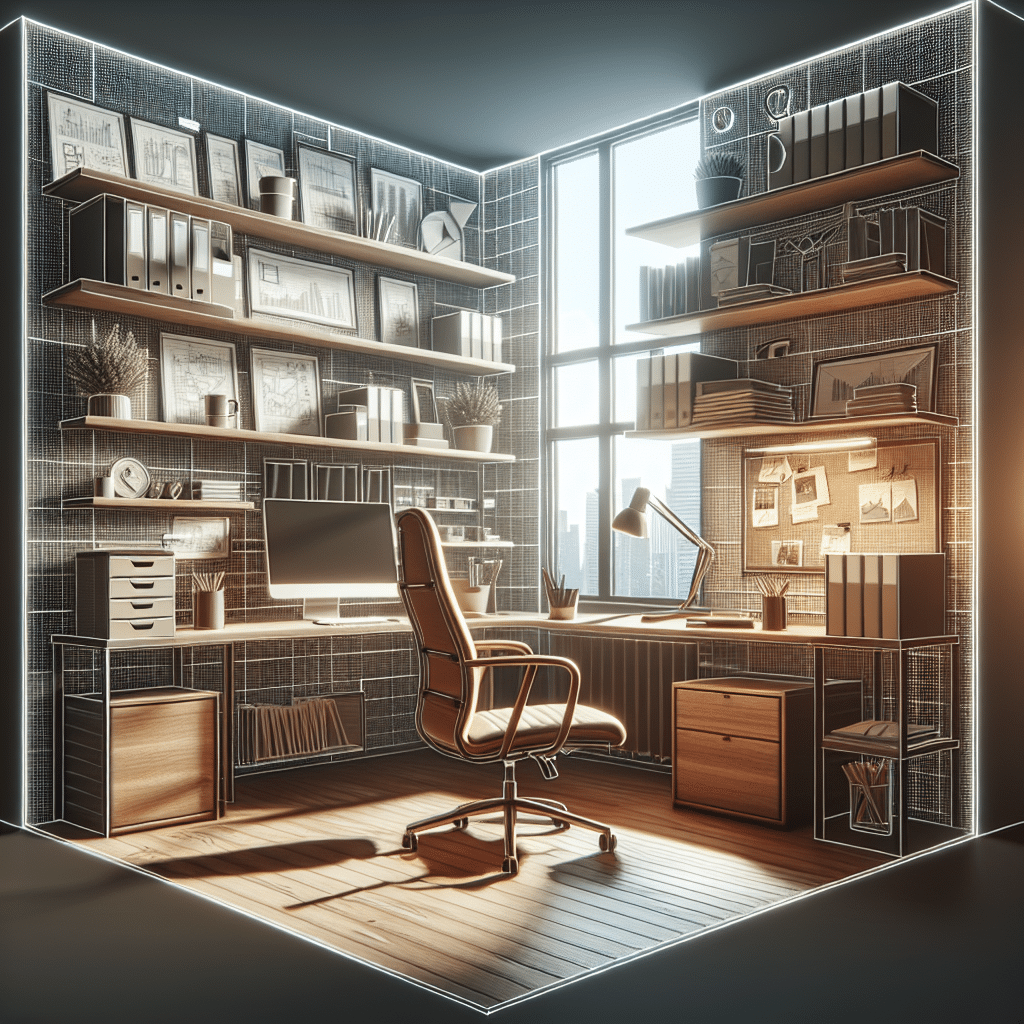Understanding the Space
Before diving into furniture placement, it’s essential to understand the dynamics of your home office space. Measure the dimensions of the room, noting windows, doors, electrical outlets, and heating or cooling systems. This spatial awareness will inform your decisions on furniture choice and placement.
Ergonomics: The Foundation of Functionality
Investing in ergonomic furniture is crucial. An ergonomic chair supports your back, encourages a healthy posture, and reduces fatigue, while an adjustable desk facilitates varying your work positions—sitting or standing. Place the desk in such a way that the screen is at eye level, around 20-30 inches away, which promotes better posture and minimizes eye strain. The chair should allow your feet to rest flat on the ground, with thighs parallel to the floor.
Optimal Desk Placement
The placement of your desk can significantly influence productivity. Ideally, position your desk facing the entrance of the office. This placement not only fosters a sense of authority but also allows you to keep an eye on the room’s activity. If the entrance is behind you, consider a U-shaped layout that creates a natural barrier, providing both focus and security.
For small spaces, a corner desk can maximize space without sacrificing functionality. Corner desks allow for easy computer access and provide additional surfaces for paperwork or office essentials. Combining vertical shelving can further enhance the use of space without cluttering the floor.
The Role of Light
Natural lighting enhances mood and productivity. Place your desk near a window to harness daylight, but be cautious of glare on your computer screen. Position your monitor perpendicular to the window to minimize eye strain; this allows for adequate lighting without causing distractions.
If natural light is limited, invest in adjustable task lighting. Place a desk lamp with an adjustable arm on one side of your desk, ensuring it illuminates your work area without creating shadows.
Incorporating Storage Solutions
Efficient home office furniture placement must include adequate storage. Clutter can detract from focus and efficiency. Begin by determining what items you use daily, and store these within arm’s reach on or around your desk.
Opt for a combination of closed cabinets and open shelving. Closed units help to keep your workspace tidy, while open shelves can display essential frequently accessed materials and decorative items. Drawers beneath the desk or filing cabinets nearby maximize space, keeping files organized and accessible.
For smaller home offices, multi-functional furniture—like a desk that doubles as a storage unit—can save valuable space while maintaining organization.
Zone Designation for Enhanced Functionality
To improve functionality, designate specific zones within your home office. A primary work zone, where your desk and computer reside, should be focused on productivity. Consider creating a secondary reading zone with a comfortable chair and a small side table for reviewing documents or reading materials.
If space allows, a separate creative or brainstorming zone can be beneficial. This area can feature whiteboards or pinboards for visual stimulation and brainstorm sessions. Keeping different activities confined to distinct zones can help in maintaining focus and improving workflow.
Technology Management
Modern workspaces rely heavily on technology. Keep all tech-related items organized and functional by creating a wire management system. Use cable trays or clips to keep cords from cluttering your desk. Place power strips in strategic locations—within easy reach but hidden from view—to maintain a clean aesthetic.
Consider integrating docking stations for laptops or tablets to keep devices organized and charged. Position technology equipment like printers or additional monitors within easy reach yet off the main work surface to minimize clutter.
Personal Touches and Aesthetics
While functionality is paramount, adding personal touches to your home office can enhance creativity and motivation. Choose a color palette that inspires you; colors like blue promote calmness, while yellow can stimulate creativity.
Incorporate plants into your office design. Not only do they add a touch of nature, but studies have shown that plants can improve air quality and increase overall wellness. Position them on shelves or cabinets, ensuring they receive sufficient light.
Artworks or mood boards can also provide inspiration. Hang these on the walls in your designated creative zone or above your desk to create an inviting and stimulating atmosphere.
Flexibility and Adaptability
As your needs change, so too should your workspace. Incorporate furniture that allows you to reconfigure your layout easily. Desks with modular components or movable storage units allow you to shift the arrangement without significant effort.
Keep in mind the need for adaptability in your furniture selection. Lightweight chairs, adjustable desks, and mobile file cabinets can help create a workspace that evolves alongside your work habits and needs.
Maintaining a Clean and Organized Workspace
Implementing efficient home office furniture placement is only part of the equation. Regularly reevaluate your setup to ensure cleanliness and organization. Schedule routine clean-ups, decluttering outdated paperwork or materials that are no longer necessary.
Invest in organizational tools like desk organizers, file trays, or inboxes to streamline daily operations. These solutions keep the workspace not only functional but visually appealing, fostering an environment conducive to productivity.
Create a Routine to Enhance Workflow
Finally, ensuring maximum functionality also involves establishing a consistent routine that complements your setup. Designate specific work hours, and align your workspace arrangement with those hours. Having a set schedule not only improves productivity but also strengthens the association between your workspace and focused work.
Creating boundaries between work and personal life is also essential in a home office. Use strategic furniture placement—such as positioning an entryway rug that separates office space from home—to help establish this boundary effectively.
Your home office is a reflection of your work style and needs. By thoughtfully considering each element, you can ensure that your space is organized, efficient, and conducive to maximum functionality.
